Dubrovnik's Tourists Spend More Per Day Than in Other Coastal Areas
As Novac writes on the 27th of March, 2019, tourists staying in both hotels and private accommodation in Dubrovnik are on average 42 years of age, of a higher level of education and possess decent paying power. They typically spend 170 euros per day on average, which is 90 euros more than the average stands in seven other coastal Croatian counties, according to a survey taken by TOMAS Dubrovnik 2018.
This research was conducted by Zrinka Marušić from the Institute for Tourism, for the needs of the City of Dubrovnik, only for Dubrovnik, conducted on a sample of 1,600 respondents.
"Dubrovnik attracts a specific sort of guest, due to broadcasting markets that aren't specific to the rest of Croatia. According to the motives of the visits, we can no longer speak of a [typical] holiday destination," Marušić said.
Namely, while visiting Croatia's southernmost city, guests are mostly attracted to new experiences, gastronomy and cultural sights, as well as swimming, local portal Dubrovački vjesnik writes.
According to the survey's data, the average daily spending of stationary guests staying in Dubrovnik is 170 euros, of which about half or 87 euros refers to accommodation, food and drink outside the accommodation facility accounts for 43 euros, culture and entertainment accounts for 14 euros, purchases account for 11 euros, etc.
The biggest spenders are from non European, more distant countries, topped quite unsurprisingly by the Americans, followed by tourists from Australia and from various Asian countries. Two thirds of Dubrovnik's stationary guests arrive in Dubrovnik with their partner, and 86 percent of them who visit the city are doing so for the very first time.
Research has shown that Croatia's long-standing tourism Mecca is a distinct airport destination as more than 85 percent of the respondents arrived by air. As many as 70 percent of the southern Dalmatian city's guests stay from four to seven days.
The city's visitors are most pleased with the beauty of the city, the levels of safety and security, the hospitality, and the typically high quality of the provided accommodation. They are least satisfied, however, with local transportation, shopping opportunities and the intolerable crowding and traffic in public places and on the city's numerous beaches.
The survey also included visitors who arrived in Dubrovnik on a cruise ship and shows that they are on average 49 years old and spend on average 51 euros per day. The most extravagant among them are once again Americans, and the most frugal are our neighbours from across the Adriatic, the Italians.
As many as 92 percent of the tourists asked were visiting Dubrovnik for the very first time, discouragingly, they are mostly ''one-day visitors'' and remain in Dubrovnik for a mere five and a half hours. Most often, they visit sights and eat at restaurants, and these guests are by far the least satisfied with the shopping opportunities and the total lack of organisation of the traffic and the huge crowds.
Make sure to follow our dedicated lifestyle and travel pages for much more. If it's just Dubrovnik you're interested in, give Total Dubrovnik a follow.
Brač: Kids With Special Needs Should Have Free Transport
Living on a beautiful Dalmatian island might be the dream of many, but the daily grind and the confronting realities of island life often pour cold water on paradise-type notions. From access to various types of transport to water to regular ferry lines to and from the mainland, life on an island isn't always what it's cracked up to be. Brač's inhabitants however, are fighting the good fight for those who need it most.
As Morski writes on the 24th of March, 2019, for years now, Brač's Red Cross has helped the Association of parents of children with developmental disabilities through numerous organised actions and various donations. Owing to this, a large number of therapies on the island of Brač have been secured, but often kids and their parents still have to go to the mainland multiple times for other therapies. With that in mind, Red Cross Brač has initiated a petition with the aim to amend the law which governs transport between the island and the mainland.
"For this reason, Red Cross Brač initiated the initiative along with ''Brač buds'' to amend the necessary law in a manner that will in the future regulate the exercise of the right to free transportation on public transport for children with developmental difficulties residing on an island who need physical, sensory, communicative, or linguistic therapy, as well as those who have intellectual difficulties when it comes to learning and development support to achieve the best possible developmental outcomes and social inclusion.
The desired change to the law will also positively affect those with severe disabilities residing on an island whose long-term physical, mental, intellectual or sensory impairments may interfere with daily life and create various and multiple obstacles to their full and effective participation in society on an equal basis with persons without disabilities.
This proposal seeks to highlight one aspect of discrimination against island children with developmental disabilities compared to the rest of the more privileged population.
Make sure to follow our dedicated lifestyle page for much more.
''Closing Dubrovnik's Cable Car to Srđ Would be Loss for Everyone''
The City of Dubrovnik wants 30 million kuna and 30 percent of future revenue for the use of the popular Srđ cable car without a concession contract.
As Marija Crnjak/Poslovni Dnevnik writes on the 21st of March, 2019, the several year long ''argument'' over the concession of the Srđ cable car has escalated to the extent it has because the City of Dubrovnik filed a lawsuit against Excelsa nekretnine (real estate) owned by the Lukšić family, accusing them of the unlawful acquisition of money. The amount that City of Dubrovnik is seeking for the use of the popular cable car without a concession agreement is 30 million kuna, as Dubrovnik's mayor Mato Franković announced last week.
He also explained that DORH had given the company a deadline which is the end of this month to comply with the law of the Republic of Croatia, to pay a concession fee to both the City of Dubrovnik and to the state, and by April the 1st, they are obliged to sign a concession agreement with the City of Dubrovnik.
If this doesn't happen, the cable car will be closed because its use would then be illegal, Mato Franković said, adding that a new report showed that the concession fee of 15 percent is too low and the belief is that it should be 30 percent. At the next session of Dubrovnik's City Council, a proposal to annul the old motion and to propose a new one will take place. In an interview with Poslovni Dnevnik, Anto Rusković, the director of Excelsa nekretnine explained why a concession contract has not yet been signed and that the company will not agree to an even higher fee than the one which was previously proposed.
Do you admit that there is a 30 million kuna debt to the City of Dubrovnik? Do you consider that the city's claim is justified?
The City of Dubrovnik filed a lawsuit against Excelsa nekretnine in the amount of 20.1 million kuna, and Excelsa nekretnine will pay as much as is determined by a final court judgment. Given that such verdicts still haven't come to pass, and in order to ensure that the City will be able to be paid if the court's verdict goes in its favour, we have offered the City of Dubrovnik the appropriate means of securing its eventual receivables in good will. It should be stressed that, if [any debt] exists at all, then it has arisen because the City of Dubrovnik hasn't offered a conclusion to the concession contract to date.
Why has a concession agreement between Excelsa nekretnine and the City of Dubrovnik not been signed yet?
Excelsa nekretnine has applied for a concession, with the concessionary terms agreed with the City of Dubrovnik, filed in August 2015, while the City of Dubrovnik hadn't issued a concession decision in accordance with the agreed terms until April 2018. In the meantime, the city brought in and then revoked several concession-related decisions, and the last one from April 2018 hasn't yet been implemented. It's necessary to clarify that we have been seeking concessions since 2010, but we had to wait for the applicable legislation by the state. The law granting concessions to cable cars entrusted to local self-government units was passed in 2014 and then we started negotiations with the city, finally agreeing on the concession conditions in July 2015. Since then, the process has only become more complex and has led us to the situation in which we find ourselves today. If the concession contract was signed in 2015 as was agreed, the City of Dubrovnik would have got its concession fee the entire time and there would be no dispute today.
Is the closure of the cable car expected?
In the potential situation of the closure of the cable car, all sides will suffer significant losses, especially Excelsa nekretnine and its partners, since the work of the cable car provides jobs for a significant number of people.
Furthermore, if the cable car closes, the state budget will lose part of the tax revenue, and the City of Dubrovnik will not receive any revenue from the concession. It's important to note that since the beginning [of the work of the cable car] Excelsa nekretnine has contributed more than 122 million kuna in taxes and contributions to the state budget, predominantly based on the cable car's business.
We believe that the scenario of its potential closure should be avoided, but we're not in a position to make such a decision. Not only are we disappointed in the way the authorities are acting, but we're also frustrated by the fact that, unsuccessfully, we've repeatedly tried to solve this problem with a reasonable and rational approach. Unfortunately, this negative attitude towards investors will not contribute to improving the investment climate in Croatia.
Do you have a license from the Ministry of Transport to work on the lift and on what basis does has it been provided?
Excelsa nekretnine received approval from the Ministry of Transport for the carriage of passengers by cable car before the cable car even started working back in 2010. At that time, such approval was granted instead of a concession due to the long duration of the concession-issuing procedure, as is written in the very approval. Had Excelsa nekretnine not received explicit permission to carry out activities of the carriage of passengers by cable car, we wouldn't have even begun doing so.
The mayor has announced that he will seek 30 percent of the revenue in the concession contract, which should be signed by April the 1st. Are you ready to agree to that?
We still haven't had any insight [into that] and we don't have access to the new expert testimony mentioned by the mayor which points to the need to increase the fee by 30 percent, so we can't comment on it either. On the basis of the previous expert testimony, we can see that such fees, twice the amount previously agreed, is unfounded. The City Council already approved the concession fee in April last year. We consider that the City of Dubrovnik should send a contract under the previously agreed terms and end this whole situation, which has already been going on for far too long.
Make sure to follow our dedicated business page for much more. If it's just Dubrovnik and the extreme south of Dalmatia you're interested in, give Total Dubrovnik a follow.
Click here for the original article/interview by Marija Crnjak for Poslovni Dnevnik
New Ferry Dock for Island of Kaprije Before Summer 2020
As Morski writes on the 21st of March, 2019, the first conference regarding the construction of a brand new ferry dock in the port of Kaprije has been held at Šibenik's city hall, handled by the Port Authority of Šibenik-Knin County.
The total value of the island's ferry dock project currently stands at over 11 million kuna, of which 9.3 million kuna is being financed by European Union funds, 1.6 million kuna is being co-financed by the Croatian Ministry of Maritime Affairs, Transport and Infrastructure, head by Oleg Butković, while the Port Authority of Šibenik-Knin County is participating in the project with a bit more than 42,000 kuna.
The details of the new Kaprije project were presented to those gathered by the director of the competent port authority, Željko Dulibić, who pointed out that the new pier will be 55 meters long, with a surface measurement of 330 square metres, and will allow for vessels with deeper beams that are less susceptible to the impact of winds to dock, and so that the island of Kaprije's inhabitants will be better connected to the mainland.
The location on which the ferry dock is set to be constructed is located in an area which is managed by by the Port Authority of Šibenik-Knin County and is located about 700 metres northwest of the centre of Kaprije.
The main objectives of the project are to improve the traffic connections of the island of Kaprije with the mainland City of Šibenik and the other islands which belong to the Šibenik archipelago, improve traffic safety within the centre of the bay and Kaprije, improve the access of Kaprije's residents to their respective workplaces, education facilities, medical facilities and other such locations which typically lie on the mainland, and reduce traffic congestion and noise as well as aim to improve overall traffic safety within the centre of the bay and Kaprije.
The current foreseen deadline for the completion of this infrastructure project is summer 2020.
Make sure to follow our dedicated business and lifestyle pages for much more.
Vela Luka: Construction of Passenger Terminal and Fishing Port in 2019
As Morski writes on the 21st of March, 2019, a session of the Municipal Council of Vela Luka on the island of Korčula was attended by the county's deputy prefect Joško Cebalo, who expressed the wider county's support for all of the innovative projects currently being prepared and implemented by the municipality, which are aided by EU funds.
''This time especially, I'd like to emphasise sincere congratulations to all of the employees of Vela Luka's home for the elderly for the municipal award that will be given to them today,'' Joško Cebalo stated, adding that the project of energy renovation for the home, which is worth more than four million kuna, will soon begin.
Port infrastructure is still seen as a top priority for Vela Luka. Deputy Prefect Cebalo stressed the fact that this issue really is a matter over which the county's administration is continuing to take care and that one of its main priorities is the continued renewal and further construction of Vela Luka's highly important port infrastructure.
According to him, the county is currently preparing as many as eight projects worth over 500 million kuna in total, and the most important for Vela Luka's residents were highlighted, these include the construction of a new ferry-passenger terminal worth 60 million kuna, which should be implemented this year, and the project of the construction of a fishing port, for which the project documentation is currently being prepared.
''As the completion of the construction of Pelješac bridge will be the symbol of the first decade of Croatia's membership of the European Union, these two projects in Vela Luka will symbolise [our] development thanks to EU funds, as well as our care for the islands,'' concluded Vela Luka's deputy prefect.
Make sure to stay up to date on the construction of infrastructure in Vela Luka and far beyond by following our dedicated lifestyle and business pages. If it's just the island of Korčula you're interested in, give Total Korčula a follow.
Learn the 10 Commandments of Dalmatia... and Zagorje
March 21, 2019 - A little Croatian humour looking at some regional stereotypes - do you know the 10 commandments of Dalmatia and Zagorje?
I heard a joke in the pub in Germany a few years ago that made me laugh out loud.I heard a joke in the pub in Germany a few years ago that made me laugh out loud.
"What is the most precious and rarest liquid in the world?"
"Dalmatian sweat."
Which leads, of course, to stereotypes - are Dalmatians really lazy?
As I explained in an article on the subject 4 years ago (Are Dalmatians Really Lazy?), some of the hard-working people I have ever met are Dalmatian. As are some of the laziest.
But stereotypes are stereotypes, and they are often best reflected with humour. I realised this morning that in all my 8 years of writing about Dalmatia, I have never published the 10 Dalmatian Commandments. Author unknown and available in various places online, including Romwell.
10 Dalmatian Commandments
'10 Dalmatinskih Zapovjedi'
1. Covik se rodi umoran i zivi da se odmori.
Man is born exhausted and lives to rest.
2. Jubi posteju svoju ka samoga sebe.
Love thy bed as thyself.
3. Odmaraj se danju da nocu mozes spavati.
Rest during the day that you may sleep well at night.
4. Ne radi, rad ubija.
Do nothing, work kills.
5. Kad vidis nekoga da se odmara, pomozi mu.
When you see someone resting, help them.
6. Ne cini danas ono sto mozes sutra.
Do not do today what you can do tomorrow.
7. Radi manje nego mozes, a ono sto mozes prebaci na drugoga.
Work less than you can, and re-delegate everything you can.
8. U ladu je spas, od odmaranja niko nije umra.
Salvation is in a shade, nobody dies resting.
9. Rad donosi bolest, ne umri mlad.
Work brings infirmity, do not die young.
10. Kad pozelis radit, sidi, pricekaj, vidit ces da ce te proc.
When you feel like working, just wait a bit, it will pass.
author unknown
And it is not just Dalmatia which has its own 10 commandments, as I discovered when I moved north to Varazdin County a couple of years ago, where I learned the Zagorje Commandments. Over a gemist or three, of course.
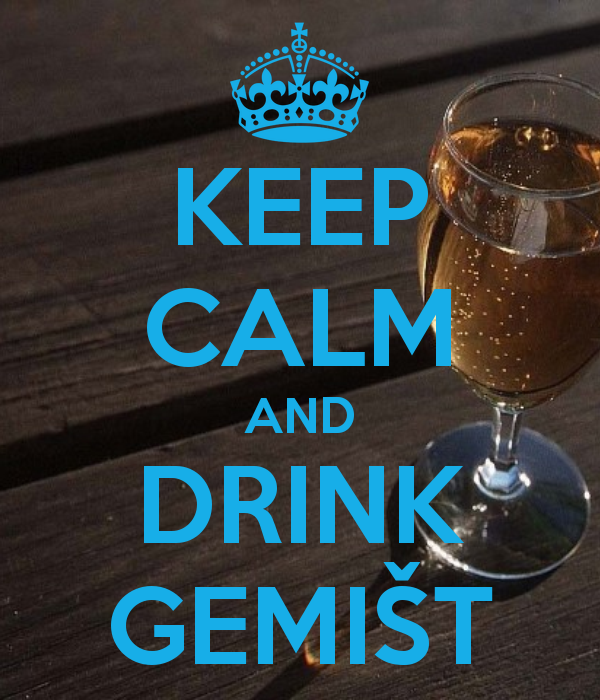
10 Zagorje Commandments
10 Zagorskih Zapovedi'
1. Tuzi bliznjeg suseda da on ne bi tebe.
Sue thy nearest neighbor, lest he sue you.
2. Ak' susedu crkne krava, ti moras ubit dve da bi bil bolji od njega.
If thy neighbor's cow dies, kill two of yours that you may outdo him.
3. Sto cesce podvaljuj pajdasu svomu, nek mu se smije cela birtija.
Whoever cheats his pal, may the whole tavern cheer him.
4. Klet ti je jedina crkva gde se spominjes imena boga svoga uzalud.
A curse is the only church where saying your Lord's name falls on deaf ears.
5. Treniraj s'aki dan sto vise da bi se uspel vise put na dan napit i: otreznit.
Practice more often every day that you may all the more frequently drink and sober up.
6. Tvoje je vino najboije u celom Zagorju. YOUR wine is the best in all of Zagorje.
7. Ljubi trseka svoga i kumu Baru ispod njega vise neg samog sebe.
Love thy vineyard and thy barrel more than thyself.
8. S'aki Zagorec mora bit dobar pajdas, muzikas i trinkas.
Every Zagorec must be a good buddy, a good singer, and a good drinker.
9. Seti se covek da je Zagorec najpametnejsi na svetu i nema pametnijeg: od njega.
Remember that the Zagorec is the smartest in the world and that none are smarter than he is.
10. Nikad nemoj priznat da si Zagorec, jer buju sve odmah znali o tebi.
Never admit to being a Zagorec, for they will immediately know all about you.
author unknown
Five Things Not to Miss Along Dalmatia's Cetina River
Since back during ancient times, proximity to water meant life, and now even in the 21st century it is still exactly the same. One of the most rich rivers in Croatia is the Cetina river, found in the rocky Dalmatia region, which breathes life into everything near and surrounding it. Undoubtedly, this 105km long river offers an assortment of benefits to the local population from; powering several hydropower plants, acting as a source of fresh drinking water and being the back one to the growing Croatian family adventure tourism market.
From the water source’s majestic beginnings, at a height of 385 metres in the Dinara mountains to its humble end, emptying into the Adriatic Sea, the Cetina has many personalities to enjoy. In this article, I will tell you a little more about my favourite sections of the river and how to enjoy it safely and with full respect to nature.
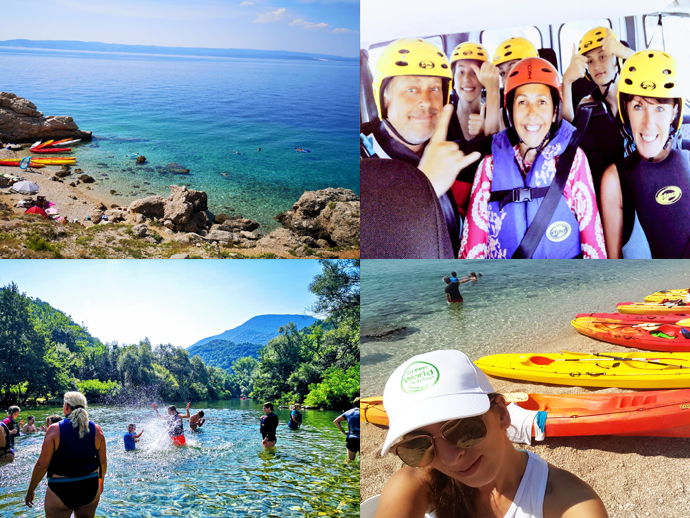
Green World Holidays
River tubing
River tubing is great fun, and not just for adults but also for active families holidaying in Croatia. Sitting in giant inflatable donuts, you’ll have the unique opportunity to descend down small river rapids powered only by your hands and feet. Located slightly north of the village of Kučiće, there is a perfect three-kilometre river section, with many memorable twists and turns. If you want to splash and have fun, and see the Dalmatian hinterland from a very rare perspective, then I can highly recommend this activity when visiting the Cetina river.
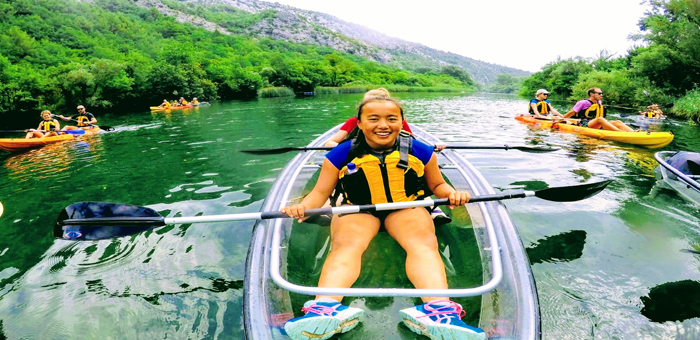
Green World Holidays
Kayaking
All over the world, kayaking is enjoyed as a recreational sport and its particularly popular in Croatia. Our country is blessed with an abundance of pristine rivers, lakes and a stunning coastline, so there are no shortages of places to rent a kayak and enjoy a water adventure. From my experience as a guide, one of the best kayak routes can be found on the Cetina, as the water transcends from sparkling emerald waters to the blue signatures of the Adriatic Sea. This picture postcard perfect route also runs through Omiš, one of the prettiest towns in Dalmatia. Famed for its historical pirates, bringing fear to the whole of the Mediterranean sea throughout the 12th and 13th centuries.
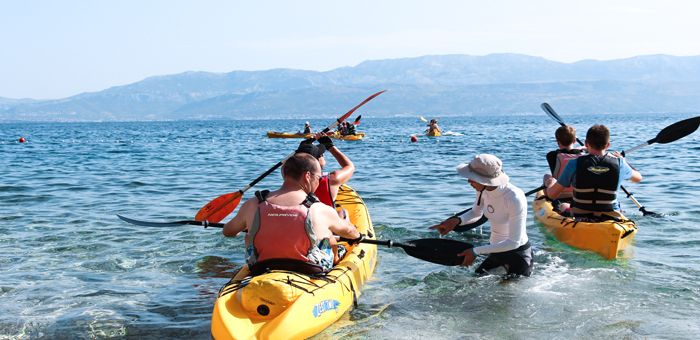
Green World Holidays
Although there are no pirates in Omiš now, I can still guarantee that this is one of the most memorable kayak experiences available. In addition, and unique to the Cetina river, guests can rent see-through kayaks, so as you paddle down the river you can explore the flora and fauna growing along the bottom of the river and enjoy feeling one with the water.
Mini rafting
As a qualified rafting guide for many years, I’ve been fortunate to have experienced the best sides to the Cetina river, and still to this day, one of my favourite activities is mini rafting. Unlike kayaking and river tubing, mini rafting is done on the northern part of the Cetina river, where you’ll find exciting river rapids and challenging waterfalls to descend. Going down the class 2 and 3 rapids (the scale is up to 6) in an inflatable canoe raft is an
adrenaline packed adventure. Along this section of the Cetina, adventurous families will discover one of the prettiest river beaches, called Stružica, which is very popular among the locals.
Professional tours typically conclude in the village of Blato na Cetini and over there you can have lunch in a little restaurant along the bank of the river. This has become a popular tour for family activity holidays in Croatia, allowing parents to better bond and connect with their teenagers, as they steer their own destiny along the Cetina river.
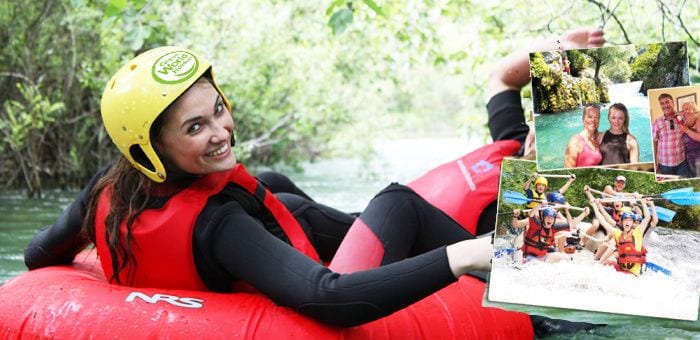
Green World Holidays
Canyoning
Canyoning along the Cetina is an unmissable adventure activity when visiting this Dalmatian region. Expert guides help lead the way and help adventurous guests to plunge into these newly discovered rocky areas and clear waters, providing the most exhilirating and unforgettable experience. It’s a true treat to be able to swim underneath powerful waterfalls, flow down naturally formed chutes, and jump into emerald pools of water. It's more fun than you can imagine and that’s why it's an unmissable experience when visiting anywhere close to the Cetina river.
If you decide to do the extreme version (not for families!) you can abseil down next to one of the highest waterfalls in Croatia, Gubavica (56 metres high). The starting point is in the village of Zadvarje and the finish is next to the oldest power plant on the Cetina river, called Kraljevac. Unlike white water rafting, canyoning is ungraded. So before booking with any sports agency, ask the right questions and discuss what you can expect with the experience. Remember, no canyon is the same!
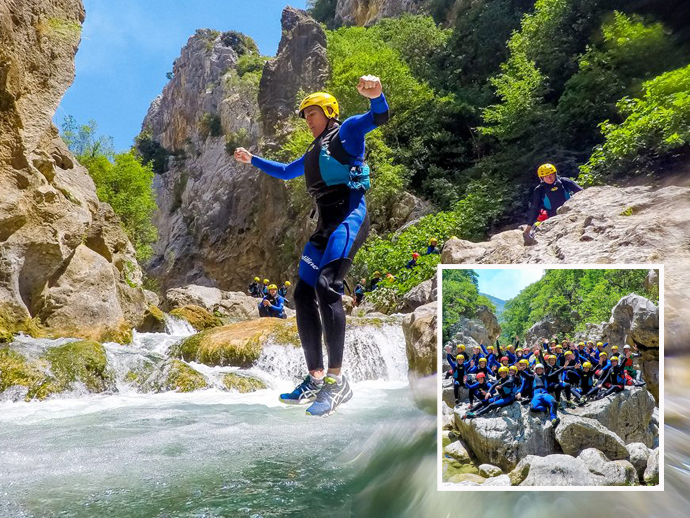
Green World Holidays
White water rafting
White water rafting is the most popular activity on the river Cetina. The route that you pass along this section of the river is about 10 kilometres long and you will face Grade 2 and 3 rapids. The starting point is north of the village of Kučiće and concludes next to one of the most famous restaurants in Dalmatia, Radmanove Mlinice. On the river, there are a lot of agencies that provide eight-man rafting tours.
Active and sustainable tourism
I hope this article has inspired you to explore the river Cetina and please remember to respect nature. We only have a future if we look after our planet now and give back to the environment and local communities. To try these activities with an Eco-friendly travel company, then contact – Green World Holidays –– a company that believes in sustainable tourism to create wonderful family activity holidays in Croatia. See their INSTAGRAM STORIES – www.instagram.com/
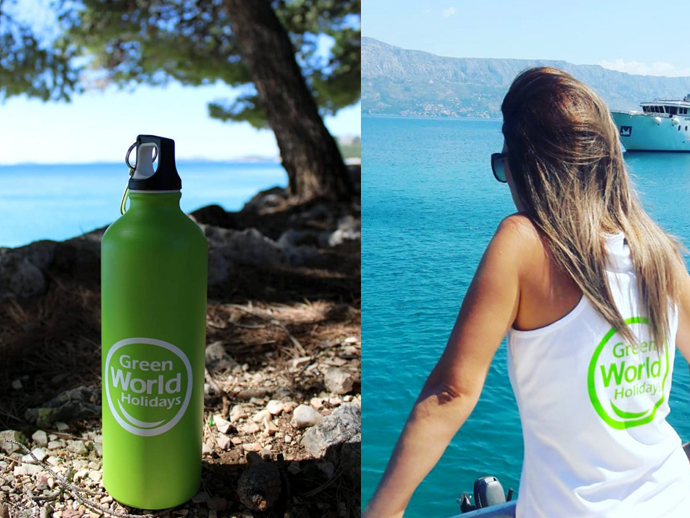
Green World Holidays
Follow our dedicated lifestyle and travel pages for more. If it's just inland Dalmatia you're interested in, give Total Inland Dalmatia a follow.
Chef's Stage in Šibenik: Gastronomy Influences Perception of Destination
As Morski writes on the 18th of March, 2019, yesterday one of the most important gastronomic congresses in the Republic of Croatia - the Chefs' Stage, began. The gastronomic event has been taking place in the historic Dalmatian city of Šibenik from the 18th to the 19th of March, and has been attended by the State Secretary of the Ministry of Tourism, Frano Matušić.
This Šibenik-based gastro event, which brings together some of the greatest names of both the Croatian and the international gastro-scene, has created discussions on a number of issues related to gastronomy and the hospitality sector, with the aim of linking those who work in tourism, hoteliers, manufacturers, suppliers, influencers, and all other types of professionals within the industry, as well as all enthusiasts of a high quality gastronomic scene.
At the very beginning of Šibenik's Chefs' Stage, the importance of gastronomy for Croatian tourism was pointed out by the longtime Croatian Minister of Tourism, Gari Cappelli:
''As many as 93 percent of tourists take part in some kind of ''special experience of food and drink'' during their trip, suggesting that today, gastronomy is a piece of content that can significantly affect the perception of an entire destination and influence the level of satisfaction guests have with their overall tourist experience. Croatia is successfully building its image as a high quality gastronomic destination, which is best acknowledged by our recognition by the world renowned Michelin and Gault & Millau guides, and with further connectivity with local producers and building ''stories and experiences'' related to our eno-gastronomic products, Croatia can become one of the gastro icons of Europe,'' Capelli stated.
During the two day Chefs' Stage, there were numerous panel discussions, masterclasses with well-known chefs, and lectures on gastronomy with the beautiful backdrop of Šibenik adding to the ambience. Among other things, the panel related to the project of linking the food-processing sector and the tourism sector through the establishment of local production systems and the territorial branding of the Republic of Croatia as a recognisable gourmet destination. It is a project aimed at positioning Croatia as a gastro icon affirmed through local foods, authentic tastes, and diverse cultural heritage, and for that purpose an action plan for the development of gastro tourism will soon be presented.
The panel titled "What Croatia needs" was attended by Secretary of State Frano Matušić, who himself emphasised the fact that gastronomy is one of the foundations of the development of year-round tourism. He said that according to research by TOMAS Summer 2017, gastronomy was highlighted as one of the main motivators for the arrival of guests in Croatia. Namely, according to that piece of research, as many as 29 percent of respondents emphasised gastronomy as a motive for making Croatia their choice.
''A large contribution will be given by the Competence centre which will, through networking and cooperation with powerful foreign centres, contribute to strengthening the quality of education in the tourism and hospitality trade, which will ultimately affect the quality of our country's gastronomic offer,'' concluded Matušić.
The second edition of the largest gastronomic congress in this part of Europe - Chefs' Stage, brought 50 Croatian and 33 international chefs and other professionals together in Šibenik over a two day period, with products being presented by 70 Croatian producers and winemakers, along with the presence of representatives of various gastro-oriented international media.
Make sure to follow our dedicated lifestyle page for much more.
Could Dubrovnik's Beloved Srđ Cable Car Face Closure?
The Pearl of the Adriatic is known for its wealth of natural beauty in addition to its rich list of historical and cultural attractions. Dubrovnik is visited by millions from around the world year on year, and in addition to its magnificent walls, which are among the most impressive Medieval structures which are still standing today in Europe, its cable car which attracts seemingly endless queues during the summer months is unarguably among its top tourist attractions.
While the typical ''fights'' about Dubrovnik's cable car are almost identical to those frequently had over the old city walls - the price, there appears to be much more going on under the surface when it comes to perhaps the most expensive three minute ride you'll ever take.
For a single adult, a mere three minute cable car ride from just above the Old City of Dubrovnik to the top of mount Srđ and back comes with a price tag of 150 kuna. Dubrovnik's locals get it cheaper, however many avoid the cable car entirely, opting instead to hike or drive up the rugged 412 metre mountain which towers over the city.
Srđ is, despite the apparently eternally increasing cost of the use of the cable car, a unique must-see location when in Dubrovnik. The mountain provides stunning views over the extreme south of Dalmatia, the sparkling Adriatic sea and the Elaphite islands (Lopud, Koločep (Kalamota) and Šipan), and when turning around, a view over the mountainous and somewhat baron interior of neighbouring Bosnia and Herzegovina, the border of which is extremely close to Dubrovnik (Ivanica).
In addition, a restaurant and the Homeland War Museum sits at the top of Srđ, housed in an unassuming Napoleonic building known as Fort Imperijal. The museum should be visited by all those wanting to learn more and pay their respects to the sacrifice made by Dubrovnik's brave defenders during the Yugoslav and Serbo-Montenegrin attacks on the UNESCO protected city in the not so distant past.
Alright, now we're done talking about Srđ as a destination, let's get to the point. 150 kuna per ride or not, it seems that one of Dubrovnik's top attractions, the cable car, could be threatened with closure, according to a report from RTL vijesti (news).
As Poslovni Dnevnik writes on the 18th of March, 2019, according to Dubrovnik's mayor Mato Franković, DORH (State Attorney's Office of the Republic of Croatia) has given the somewhat ''famous'' Lukšić family company until the first April to pay huge compensation to the City of Dubrovnik and to the state, and to sign a concession agreement. Otherwise, the iconic cable car will be suspended.
A 150 kuna price tag for a three minute ride up a mountain is a bit steep (no pun intended, well, maybe a bit), and as prices for some of Dubrovnik's main attractions continue to rise, many tourists are beginning to become disillusioned with the Pearl of the Adriatic's offer. "For 150 kuna, I think the ride is too short, but the view is fantastic," said Indian tourists Karthi and Sushma.
It is precisely that beautiful view that makes the cable car as popular of an attraction as it is, and there is always row after row of tourists standing along the poorly laid out street with no shade (which also acts as a bus stop for regular city buses and for the airport shuttle) regardless of the ticket price.
The cable car's turnover stands at about 60 million kuna per year, Excelsa real estate accounts for about 65 percent of the net profit, while the City of Dubrovnik has apparently never even received even one kuna in revenue from the cable car. Could all that be about to change in a matter of mere days? Apparently so.
Make sure to follow our dedicated business and news pages for more. If it's just Dubrovnik and the extreme south of Dalmatia you're interested in, give Total Dubrovnik a follow.
Group of Young Croats Create e-Vision Project for the Blind
For such a small country, the Republic of Croatia boasts a wealth of talent across all fields, from medicine to sport and from science to innovation and invention, Croats have given a huge amount to the rest of the world.
While Zadar's Luka Modrić might be the household name of Croatian sport, and the likes of Nikola Tesla and Mate Rimac might be the Croats best known to the world when it comes to science, technology and innovation, there are many more individuals in Croatia given less exposure who have a lot to offer the world, and on across an extremely varied platform consisting of all fields.
As SibenikIN writes on the 16th of March, 2019, a young woman from the historic Dalmatian city of Šibenik, Anastazija Verović, a student of FESB, along with her colleagues, has designed an innovative new device for helping the blind. Thanks to her creation, Anastazija and her team have received yet another award from Split-Dalmatia County for this project,.
Anastazija Verović, Lucija Visković, Ena Sarajlić and Ana Žunabović, are all Croats in their fifth year of graduates studies in computer science at FESB and they expressed their desire to help both the blind and other partially sighted people.
Their desire led this talented young group of Croats to create the e-Vision project, an intelligent device which functions as a bracelet and allows blind and visually impaired persons to move around in spaces. For this praiseworthy project, they have rightfully received a second award in the amount of 4,000 kuna from Split-Dalmatia County.
Split-Dalmatia County Prefect Blaženko Boban presented the presented the award to the talented group of FESB students as the brains behind the best student entrepreneurial and innovative project, according to a report from Dalmacija News.
The first prize of 5,000 kuna was awarded to the e-Agrar project, and was handed over to another talented group of Croats - Slaven Damjanovic, Martin Pervan, Dražen Pervan and Marko Calić. Otherwise, the obviously highly talented Anastazija is set to graduate computer science at FESB this coming summer.
Make sure to stay up to date on Croatian-made innovation, ideas and technology by following our dedicated Made in Croatia page.


